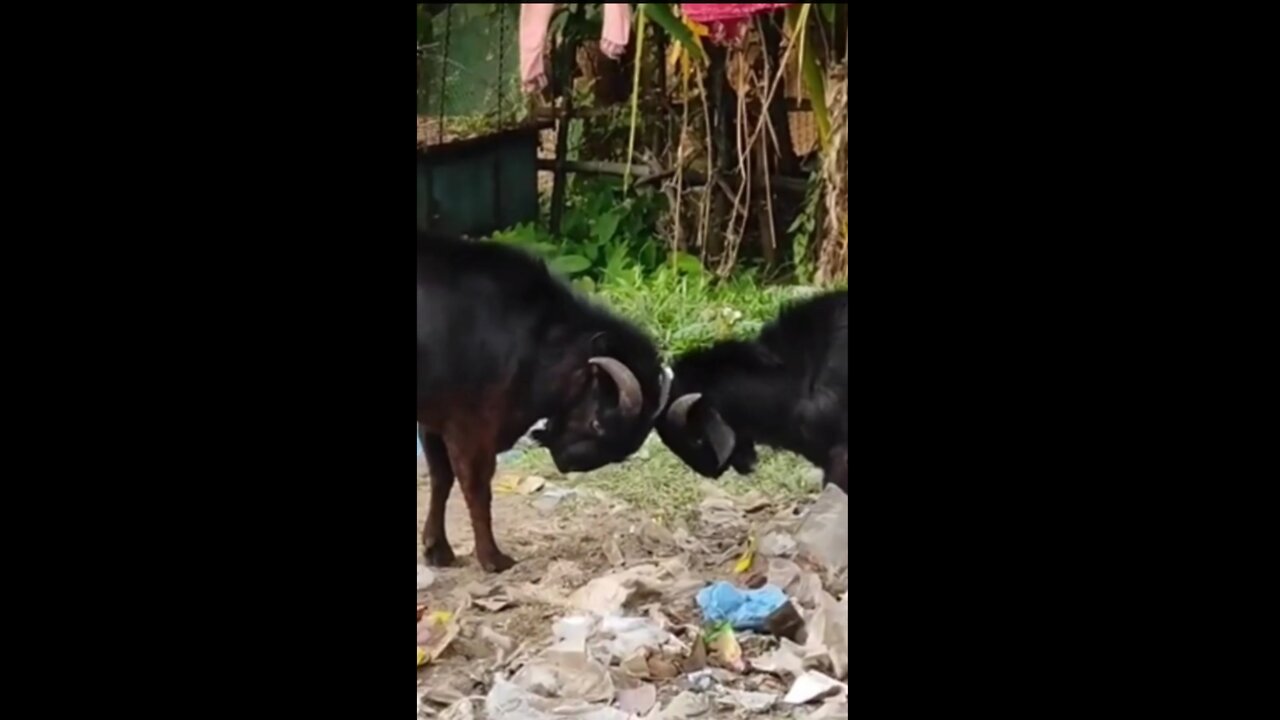Premium Only Content

Two goat fighting.
The goat or domestic goat (Capra hircus) is a domesticated species of goat-antelope typically kept as livestock. It was domesticated from the wild goat (C. aegagrus) of Southwest Asia and Eastern Europe. The goat is a member of the animal family Bovidae and the tribe Caprini, meaning it is closely related to the sheep. There are over 300 distinct breeds of goat.[1] It is one of the oldest domesticated species of animal, according to archaeological evidence that its earliest domestication occurred in Iran at 10,000 calibrated calendar years ago.
Domestic goat
Temporal range: 0.01–0 Ma
PreꞒ
Ꞓ
O
S
D
C
P
T
J
K
Pg
N
↓
Neolithic–Recent
A pygmy goat on a tree stump
Conservation status
Domesticated
Scientific classificationKingdom:AnimaliaPhylum:ChordataClass:MammaliaOrder:ArtiodactylaFamily:BovidaeSubfamily:CaprinaeTribe:CapriniGenus:CapraSpecies:
C. hircus
Binomial nameCapra hircus
Linnaeus, 1758
Synonyms
Capra aegagrus hircus Linnaeus, 1758
Capra depressa Linnaeus, 1758
Capra mambrica Linnaeus, 1758
Capra reversa Linnaeus, 1758
Goat-herding is an ancient tradition that is still important in places such as Egypt.
Goats have been used for milk, meat, fur, and skins across much of the world.[3] Milk from goats is often turned into goat cheese.
Female goats are referred to as does or nannies, intact males are called bucks or billies, and juvenile goats of both sexes are called kids. Castrated males are called wethers. While the words hircine and caprine both refer to anything having a goat-like quality, hircine is used most often to emphasize the distinct smell of domestic goats.
In 2011, there were more than 924 million goats living in the world, according to the UN Food and Agriculture Organization.
-
 13:12
13:12
The Pascal Show
16 hours ago $0.01 earnedTYLER'S ARREST FOOTAGE MISSING?! Local Police Claim Tyler Robinson Arrest Footage Has BEEN DELETED?!
48 -
 LIVE
LIVE
Lofi Girl
2 years agoSynthwave Radio 🌌 - beats to chill/game to
171 watching -
 1:37:16
1:37:16
omarelattar
17 hours agoEx-Mafia Boss: I Made $8 Million Every Week Until The FBI Destroyed My Life! What I Learned...
10 -
 57:44
57:44
TruthStream with Joe and Scott
1 day agoShe's of Love podcast and Joe co-Hosted interview, Mother Claudia and Daughter Juliette: Traveling, Home School, Staying Grounded, Recreating oneself, SolarPunk #514
3.26K -
 2:32:42
2:32:42
CAMELOT331
2 days agoCAMELCAST 107 | CECIL SAYS | My Last Stream? Being Kicked Off Youtube
1.78K2 -
 1:16:28
1:16:28
Man in America
15 hours agoThe Study They Tried to BURY: Covid Shots Cause MASSIVE Spike in Cancer w/ Dr. Makis
171K40 -
 2:07:43
2:07:43
Inverted World Live
8 hours agoNASA Finds Strange Rock on Mars w/ Cody Dennison | Ep. 145
95.4K5 -
 3:29:04
3:29:04
TimcastIRL
7 hours agoTrump Calls For DEATH Of Democrats For Sedition, White House WALKS IT BACK | Timcast IRL
244K138 -
 24:13
24:13
Jasmin Laine
12 hours agoPoilievre Can’t Stop LAUGHING—Liberals IMPLODE After U.S. Ambassador Calls Them Out
24.6K21 -
 4:04:31
4:04:31
SpartakusLIVE
9 hours agoTexas FARMBOY turned WZ PRO turned REDSEC HERO turned ARC LOOT GOBLIN
56.8K